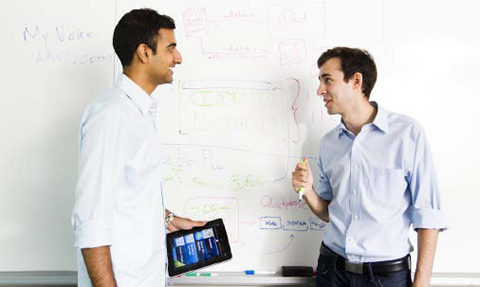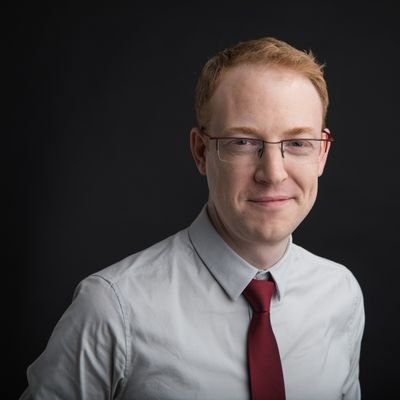Freedom of speech is one of our most treasured human rights. But some medical conditions − including some types of autism, strokes or Lou Gehrig’s disease − can rob people of their ability to talk. A U of T alum and two students aim to help patients express themselves again with a new technology called MyVoice.
“The devices that currently exist to help people communicate are extremely expensive, and really bad,” says Alexander Levy (BA 2010 UC), MyVoice’s CEO and lead designer. The project’s origins lie with Bill Scott, a patient at the Toronto Rehabilitation Institute who had developed an acute speech impediment after a stroke. Unable to talk reliably on his own, Scott was given an assistive speech device – a clunky computer that speaks words aloud when he taps or selects them from a list. Like many people using such machines, he found it slow, difficult to use and a battery hog (sometimes lasting only a few hours). But unlike those other patients, Scott was referred to U of T’s Technologies for Aging Gracefully lab (TAGlab) in the department of computer science. The TAG team knew they could build something better.
Levy and his colleagues – Aakash Sahney, who is in the professional experience year of his engineering degree, and Kevin Tonon (BSc 2007 VIC), a master’s student in computer science – found a solution literally in their own back pockets. The iPhones and Android smartphones they were already carrying had speakers, touch screens and Internet access. Write some software, they concluded, and presto: a next-generation speech aid for a few hundred bucks (current devices run up to $15,000). Because smart phones have GPS built in, MyVoice is the first speech aid that can tailor its words by location. At a movie theatre? MyVoice shows you words such as “tickets” and “popcorn,” and because it’s Internet-connected, it can download new vocabulary on the fly. Finally, it boasts a polished, glossy aesthetic that its ugly-stepsister tablets can’t match. “There’s a lot to be said for strong design,” says Sahney, noting that MyVoice’s users may have cognitive impairments or scant technological literacy.
MyVoice won its first award before the software was even finished, a $2,500 prize from the Ontario Centres of Excellence (a provincial technology incubator) for a video explaining the technology. In early 2010, search giant Google awarded Levy’s team a $50,000 research award and some Android phones to work on.
Levy and his team officially launched MyVoice as a free app for iPhone and Android last spring, and by early August the software had been downloaded 6,000 times. Levy planned to unveil a version of MyVoice for the iPad in September, along with a subscription service that will allow users to extensively customize the program with their own words, pictures and phrases. The team is promoting MyVoice in the medical community, and investigating potential applications for the program in special education.
Showing off the software in their seventh-floor lab in the Bahen Centre, Levy and Sahney describe their enthusiasm for their project. “We’re psyched,” says Levy, pausing a moment to pick just the right word. If MyVoice takes off, tens of thousands – perhaps even millions – of people could similarly find themselves never again at a loss for words.
Recent Posts
For Greener Buildings, We Need to Rethink How We Construct Them
To meet its pledge to be carbon neutral by 2050, Canada needs to cut emissions from the construction industry. Architecture prof Kelly Doran has ideas
U of T’s 197th Birthday Quiz
Test your knowledge of all things U of T in honour of the university’s 197th anniversary on March 15!
Are Cold Plunges Good for You?
Research suggests they are, in three ways






One Response to “ Say the Right Thing ”
@Alex I work in a special day school in which all of the children have developmental and intellectual delays. They are unable to read, but some of them can communicate through PIC symbols.
Is there any chance that you can adapt this program to use symbols or pictures of signs? This would open up the program to a whole different range of people. Even deaf children, who do not yet read at a high level, could use this app by reading the signs.
Just an idea, but i think it would be awesome. What do you think?
Sharon